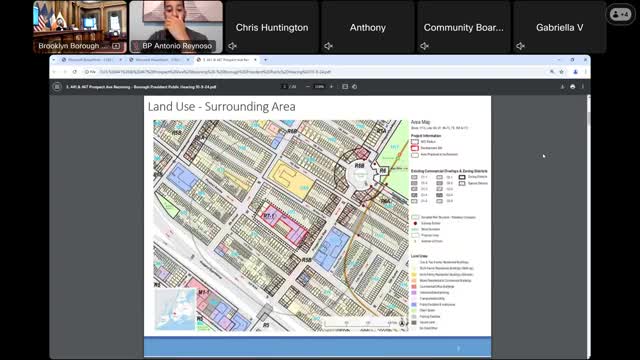Community debates new affordable housing project amid rezoning plans
October 09, 2024 | Kings County - Brooklyn Borough, New York
This article was created by AI summarizing key points discussed. AI makes mistakes, so for full details and context, please refer to the video of the full meeting. Please report any errors so we can fix them. Report an error »

In a recent government meeting, discussions centered around a significant application from Arrow Linen Company, which seeks to redevelop its long-standing commercial laundry site on Prospect Avenue in Community District 7. The proposal includes three key land use actions: a zoning map amendment to change the current R5B designation to R7-1, a text amendment to establish a Mandatory Inclusionary Housing (MIH) area, and a special permit to waive parking requirements.
Arrow Linen, a family-owned business operating since the 1970s, aims to transition the site from its non-conforming commercial use to residential development. The proposed plan includes two 13-story buildings, totaling approximately 248,000 square feet and 244 dwelling units, with 25% designated as permanently affordable housing under the MIH program. This translates to around 61 units, with specific allocations for families earning 40% to 80% of the Area Median Income (AMI).
The redevelopment plan also emphasizes environmental sustainability, proposing nearly half an acre of open space to enhance the neighborhood's green space and improve stormwater management. The design incorporates features such as permeable paving and bioswales to address runoff issues, alongside energy-efficient building practices.
During the meeting, representatives raised questions about the project's affordability and urban design compatibility with the surrounding residential area. The applicant expressed openness to discussions with the Department of Housing Preservation and Development (HPD) regarding additional affordable units beyond the MIH requirements.
The choice of the R7-1 zoning designation was highlighted as a strategic decision to allow for greater flexibility in building design while minimizing the bulk of the structures. The applicant noted that the current R5B zoning would not support financially viable residential redevelopment, as it lacks inclusionary housing mandates.
Community feedback has been a crucial aspect of the planning process, with concerns about building height and massing being addressed. The applicant indicated a willingness to explore alternative designs that could maintain the same density while potentially reducing the overall height of the buildings.
As the project moves forward, it will undergo further review and ultimately require approval from the city council, with the timeline for decisions becoming increasingly pressing. The outcome of this proposal could significantly impact the local housing landscape, particularly in terms of affordability and community integration.
Arrow Linen, a family-owned business operating since the 1970s, aims to transition the site from its non-conforming commercial use to residential development. The proposed plan includes two 13-story buildings, totaling approximately 248,000 square feet and 244 dwelling units, with 25% designated as permanently affordable housing under the MIH program. This translates to around 61 units, with specific allocations for families earning 40% to 80% of the Area Median Income (AMI).
The redevelopment plan also emphasizes environmental sustainability, proposing nearly half an acre of open space to enhance the neighborhood's green space and improve stormwater management. The design incorporates features such as permeable paving and bioswales to address runoff issues, alongside energy-efficient building practices.
During the meeting, representatives raised questions about the project's affordability and urban design compatibility with the surrounding residential area. The applicant expressed openness to discussions with the Department of Housing Preservation and Development (HPD) regarding additional affordable units beyond the MIH requirements.
The choice of the R7-1 zoning designation was highlighted as a strategic decision to allow for greater flexibility in building design while minimizing the bulk of the structures. The applicant noted that the current R5B zoning would not support financially viable residential redevelopment, as it lacks inclusionary housing mandates.
Community feedback has been a crucial aspect of the planning process, with concerns about building height and massing being addressed. The applicant indicated a willingness to explore alternative designs that could maintain the same density while potentially reducing the overall height of the buildings.
As the project moves forward, it will undergo further review and ultimately require approval from the city council, with the timeline for decisions becoming increasingly pressing. The outcome of this proposal could significantly impact the local housing landscape, particularly in terms of affordability and community integration.
View full meeting
This article is based on a recent meeting—watch the full video and explore the complete transcript for deeper insights into the discussion.
View full meeting
